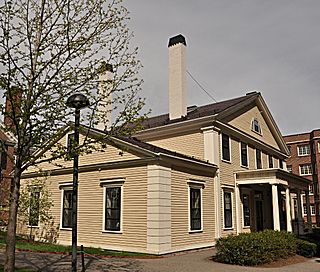
The Beck-Warren House, also known as the Warren House, is a historic house located in Cambridge, Massachusetts. Now on the campus of Harvard University, this large Greek Revival wood-frame house was built in 1833 for Professor Charles Beck, and was later purchased and adapted by the physically disabled Henry Clarke Warren, a Sanskrit scholar. Since 1899 it has belonged to Harvard University, for whom it presently houses offices. The house was listed on the National Register of Historic Places in 1996.

The Building at 104–106 Hancock Street is an historic cottage in Cambridge, Massachusetts. Built in 1839, it is a significant local example of transitional Greek Revival/Gothic Revival architecture, and one of the earliest houses built after the subdivision of Dana Hill. It was listed on the National Register of Historic Places in 1983.

The Sara Foster Colburn House is an historic house at 7 Dana Street in Cambridge, Massachusetts. Built in 1846, the 1+1⁄2-story wood-frame house is the best example of Gothic Revival architecture in the city. The building has bargeboard decoration on its front gable, which frames a deeply recessed porch with Gothic-style openings and a distinctive wrought iron railing of a type typically found only in the Connecticut River valley.

The Col. Charles Codman Estate is a historic house on Bluff Point Drive in Barnstable, Massachusetts. Built in 1870, the house is a well-preserved example of a summer seaside resort house in Queen Anne/Shingle style. It was designed by Boston architect John Sturgis, and modified in the early 20th century, adding some Colonial Revival elements. The estate was listed on the National Register of Historic Places in March 1987, and it was included in the Cotuit Historic District in November 1987.
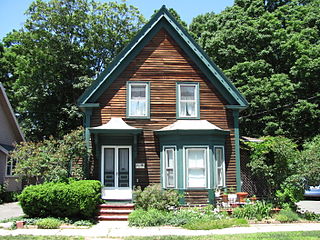
322 Haven Street in Reading, Massachusetts is well preserved cottage with Gothic and Italianate features. Built sometime before 1889, its use of even modest Gothic features is unusual in Reading, where the Gothic Revival was not particularly popular. The house was listed on the National Register of Historic Places in 1984.

The Wendell Bancroft House is a historic house in Reading, Massachusetts. Built in the late 1860s, it is one of the town's few surviving examples of residential Gothic Revival architecture, built for one of its leading businessmen of the period. The house was listed on the National Register of Historic Places in 1984.

The George Bentley House is a historic house at 9 Earle Street in Worcester, Massachusetts. Built in 1849–50, this 1+1⁄2-story wood-frame cottage is Worcester's finest surviving example of Carpenter Gothic styling. It was listed on the National Register of Historic Places in 1980.

The George Cobb House is a historic house located at 24 William Street in Worcester, Massachusetts. Built about 1875, it is a well-preserved and little-altered example of late Gothic Revival architecture. The house was listed on the National Register of Historic Places on March 5, 1980.

The John Hastings Cottage is an historic house at 31 William Street in Worcester, Massachusetts. Built about 1880, it is a distinctive example of Victorian Gothic architecture. The house was listed on the National Register of Historic Places in 1980, where it is misspelled as "Hastins".
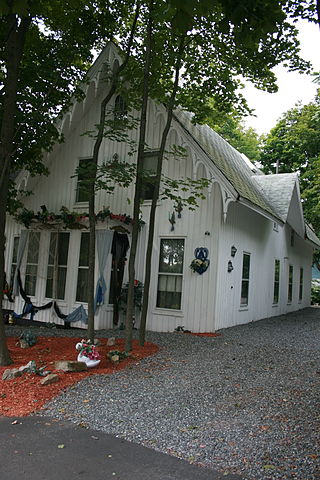
The Soho Cottage is a historic house at 21 Windsor Street in Worcester, Massachusetts. Built in 1860, it is one of the city's finest surviving examples of Carpenter Gothic architecture, owned and occupied for many years by a prominent local industrialist. The house was listed on the National Register of Historic Places in 1980.

The D. Wheeler Swift House is a historic house at 22 Oak Avenue in Worcester, Massachusetts. Built in 1879–80 to a design by the noted local architect Stephen C. Earle, it is a well-preserved example of Gothic Revival and Stick style design, which was home to a prominent business owner. The house was listed on the National Register of Historic Places in 1980.

The House at 23 Lawrence Street in Wakefield, Massachusetts is a good example of a late 19th-century high-style Colonial Revival house. Built in the late 1890s, it was listed on the National Register of Historic Places in 1989.
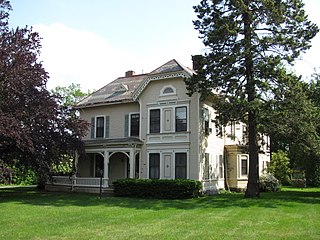
Beechwood is a historic house at 495 Main Street in Southbridge, Massachusetts. Built in 1868, it is prominent locally as a fine early example of Stick style architecture, and as one of the first houses to be built that became one of the city's upper-class neighborhoods. It was listed on the National Register of Historic Places in 1989.

The James Gleason Cottage is a historic house at 31 Sayles Street in Southbridge, Massachusetts. Built about 1830 for a local businessman, it is a regionally rare example of vernacular Gothic Revival architecture. The house was listed on the National Register of Historic Places in 1989.

The Candler Cottage is a historic house at 447 Washington Street in Brookline, Massachusetts. Built about 1850, it is one of the town's few examples of Gothic Revival architecture. It was listed on the National Register of Historic Places in 1985.

The General Simon Elliot House was a historic house at 61 Heath Street in Brookline, Massachusetts. Built in 1824, it was one of the town's oldest examples of Greek Revival architecture, owned by several prominent residents. The house was listed on the National Register of Historic Places on October 17, 1985.
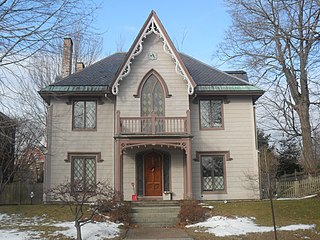
The Gothic House, also known as the John J. Brown House, is a historic house at 387 Spring Street in Portland, Maine. Built in 1845, it is one of Maine's finest and earliest known examples of Gothic Revival architecture. Although virtually unaltered, it was moved down Spring Street in 1971 to avoid demolition. It was listed on the National Register of Historic Places in 1974.

The Dr. Daniel Adams House is a historic house at 324 Main Street in Keene, New Hampshire. Built about 1795, it is a good example of transitional Federal-Greek Revival architecture, with a well documented history of alterations by its first owner. The house was listed on the National Register of Historic Places in 1989.

The Gilmore House is a historic house at 764 River Road in Calais, Maine. The 2+1⁄2-story wood-frame house was designed by New Brunswick architect Matthew Stead and built c. 1850, probably for Alexander Gilmore, an Irish immigrant and local merchant. The house is a remarkably sophisticated execution of Gothic Revival styling, given that at the time of its construction, Calais was essentially a frontier town. It is the most sophisticated of a trio of Gothic Revival houses. It is, like one of its neighbors, the George Washburn House, listed on the National Register of Historic Places, although its address has changed since its listing.
The Jonas R. Shurtleff House was a historic house on United States Route 201 in Winslow, Maine. Built around 1850, it was a distinctive local example of vernacular Gothic Revival architecture. It was listed on the National Register of Historic Places in 1974. It was demolished some time after 2018, and was delisted from the National Register in 2023.






















